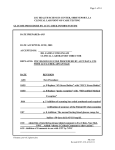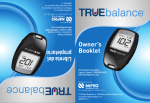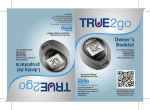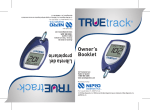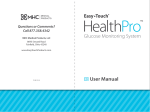Download MHC Medical Products Easy-Touch User manual
Transcript
Easy•Touch® Test Strip Instructions For Testing Glucose in Capillary Whole Blood IMPORTANT: Please read this information and your Easy•Touch® Glucose Monitoring System's user manual before using Easy•Touch® Glucose Test Strips. Intended Use The Easy•Touch® Glucose Test Strips are used with the Easy•Touch® Blood Glucose Meter for quantitatively measuring glucose (sugar) in whole blood obtained from the fingertip, palm and forearm. The Easy•Touch® Glucose Test Strips are for testing outside the body (in vitro diagnostic use). The Easy•Touch® Blood Glucose Meter is intended for use in the home and in professional settings to monitor blood glucose levels. Test Principle On each test strip there is a test area containing reaction chemicals. When blood is applied to this area, a chemical reaction takes place, then a transient electrical current is formed. The blood glucose concentration is calculated based on the electrical current detected by the meter, then the result is showed on the display. The test measures glucose from 20 mg/dL (1.1mmol/L) to 600 mg/dL (33.3 mmol/L). The Easy•Touch® Glucose Test Strip is calibrated to display the equivalent of plasma glucose values to allow easy comparison of results with laboratory methods. Precautions • For in vitro diagnostic use (outside the body) only. • Do not reuse test strips. • Do not use test strips beyond the expiration date printed on the package since this may cause inaccurate results. • Discard the vial and any unused test strips 3 months after you first open it. Constant exposure test strips to air may destroy chemicals in the test strip. This damage can cause incorrect readings. • The sample must only be applied to the tip of the test strip. Do not apply blood or control solution to the top, left or right sides of the test strip. This may cause inaccurate test results. • Use only the Easy•Touch® Blood Glucose Meter with the Easy•Touch® Glucose Test Strips. • Keep the test strip vial away from children. The cap is a choking hazard. The cap or vial contains drying agents to protect the test strips. Drying agents may be harmful if inhaled or swallowed and may cause skin or eye irritation. • Any change in medication based on the Easy•Touch® Blood Glucose Meter test results without the consent and advice of a physician or healthcare professional is not recommended. Consult your physician or healthcare professional before making changes in your treatment plan based on your blood glucose test results. • Severe dehydration and excessive water loss may cause false low results. If you believe you are suffering from severe dehydration, consult your physician immediately. • All devices contaminated with blood should be disposed of properly. Healthcare professionals should follow their institution’s infection control protocols. • If you get Easy•Touch® Control Solution test results that fall outside the range printed on the test strip vial, repeat the test with a new test strip. If the test result is still outside the range printed on the test strip vial, the Easy•Touch® System may not be working properly. DO NOT use the system to test your blood until you get a control solution test result within the range printed on the test strip vial label. Storage and Handling • Store at room temperature between 39-86 (4-30 ). Do not refrigerate or freeze. Avoid exposing test strips to extreme temperatures. • Store away from direct sunlight and heat. • Use each strip immediately after removing it from the vial. • Store your test strips in their original vial only. The cap or vial contains drying agents to protect the test strips. Do not transfer test strips to a new vial or any other container. • After removing a test strip from the vial, replace the vial cap immediately and close it tightly. • Do not bend, cut, or alter the Test Strip in any way. • With clean, dry hands you may gently touch the test strip anywhere when removing it from the vial or inserting it into the meter. How to do the Test See your User’s Manual for a step-by-step guide on how to do the test. Warning Alternate site testing (AST) should ONLY be used in the following intervals: • In a pre-meal or fasting state. (more than 2 hours since the last meal) • Two hours or more after taking insulin. • Two hours or more after exercise. DO NOT use AST if: • You think your blood glucose is low. • You are unaware of hypoglycemia. • Your AST results do not match the way you feel. • You are testing for hyperglycemia. • Your routine glucose results are often fluctuating. • If you are pregnant. 1. Select the Puncture Site to Obtain Blood You may obtain a blood drop from the fingertip, palm, or forearm. If using the forearm, choose a fleshy area away from bone, visible veins and hair. If using the palm, choose a fleshy area on the palm below your thumb or pinky finger. Select a spot with no visible veins and away from deep lines, which may cause your blood sample to smear. Wash your hands and the puncture site with warm, soapy water. Dry them thoroughly. If you use an alcohol swab, make sure the skin is dry before lancing. To help you get a large enough drop of blood, you may gently massage or apply warmth to the site to increase blood flow. Press and hold the sampler against your fingertip, palm or forearm for a few seconds, then press the release button. 2. Blood Glucose Testing Insert a Test Strip to the meter. The meter will turn on. Use the Lancing Device to obtain the right size blood drop. Refer to your Lancing Device User’s Instruction for how to lance your finger, forearm and palm. Then obtain a blood sample about the size of a pinhead. Gently touch only one edge of the Test Strip to the blood sample. You may fill the blood to the tip of test strip. Do not apply blood to the top, left or right sides of the test strip. Do not press the edge of the strip against the test site. When the strip is full of blood, the meter will “beep” or you will see the test strip chamber area completely filled. 3. Read Results Read the test results in an average of 5 seconds. The result will be stored in the meter memory. Results are displayed as mg/dL (milligrams per deciliter of blood) or mmol/L (millimoles per liter of blood) depending on the units you chose when you set up your meter. To change the units displayed, see your User’s Manual section “Setting Up the Meter.” (The mg/dL is the standard unit in the United States. Meters used in the United States must be set to read in mg/dL) What Do Your Results Mean? Normal Glucose Values The normal fasting glucose range for a non-diabetic adult is 70 to 110 mg/dL (3.9 to 6.1 mmol/L)1. One to two hours after meals, normal glucose values should be less than 140 mg/dL (7.8 mmol/L).2 For people with diabetes, consult your physician or healthcare professional for the target glucose values that are right for you. Low Glucose Values The Easy•Touch® Blood Glucose Meter displays results between 20 and 600 mg/dL (1.1 and 33.3 mmol/L). If your test result is lower than 20, “Low” (LO) will appear on the meter display. This indicates severe low blood sugar (hypoglycemia). You should immediately treat low blood sugar as recommended by your healthcare professional. High Glucose Values If your test result is above 600 mg/dL (33.3 mmol/L), “High” (HI) will appear on the meter display screen. This indicates severe high blood sugar (hyperglycemia). You should immediately treat high blood sugar as recommended by your healthcare professional. Unexpected Results Low or high blood sugar readings can indicate a potentially serious medical condition. If your blood sugar is unusually low or high, or if you do not feel the way your results indicate, repeat the test with a new test strip. If your reading is not consistent with your symptoms or if your blood glucose result is less than 60 mg/dL (3.3 mmol/ L) or higher than 240 mg/dL (13.3 mmol/L), you should contact your healthcare professional and follow his or her treatment advice. Limitations The Easy•Touch® Glucose Test Strips give accurate results when the following limitations are observed: 1. Use only the Easy•Touch® Glucose Test Strips with the Easy•Touch® Blood Glucose Meter. 2. Use only capillary whole blood from finger, palm and forearm. Do not use plasma or serum. 3. Do not use neonate samples. Easy•Touch® Glucose Test Strips are not validated for and should not be used for testing neonatal blood specimens. 4. The system is tested to accurately read the measurement of glucose in whole blood within the range of 20 to 600mg/dL (1.1-33.3 mmol/L). 5. This system can be used up to an altitude of 7545 feet. 6. The test strips are for single use only. Do not reuse test strips. Additional Information for Healthcare Professionals 7. E asy•Touch® Glucose Test Strip does not interfere with the hematocrit at a normal range (35-55%) of blood glucose. 8. Acetaminophen, uric acid, ascorbic acid (vitamin C), and other reducing substances when occurring in normal blood or normal therapeutic concentrations do not significantly affect results. However, abnormally high concentrations in blood may cause inaccurately high results. 9. Lipemic samples; Cholesterol up to 375 mg/dL or triglycerides up to 2,000 mg/dL do not significantly affect test results. However, glucose values in specimens beyond these levels, should be interpreted with caution. 10. Blood samples that contain a high concentration of dissolved oxygen may lower the test result. 11. Antiglycolysis and anticoagulants in blood samples may affect the test results. 12. Severe dehydration, diabetic ketoacidosis, hyperosmolar non-kitotic state, hypotension, shock, or peripheral vascular disease.3,4,5 may cause inaccurate results. 13. Critically ill patients should not be tested with home use blood glucose monitors as it may lead to inaccurate results. Quality Control Easy•Touch® Control Solution can be used to verify that the Easy•Touch® Glucose Monitoring system is working correctly and giving accurate results. The system is performing correctly if the control solution test result falls within the specific control solution range listed on your Test Strip vial. You are encouraged to use Control Solution on a regular basis. If you suspect your blood glucose test are not consistent with how you feel or your test are higher or lower than normal, you may validate the performance of your test with Control Solution. When a control solution test is done, you should get results within the expected range printed on the test strip vial. If control solution test results fall outside this range, repeat the test. Results that fall outside the range may be caused by: • error in performing the test, • expired or contaminated control solution, • test strip deterioration or meter malfunction. If the problem persists, the system may not be working properly. DO NOT continue to use the system to test your blood glucose level. If you continue to get results that fall outside the specified range, please call Customer Service. Note: Easy•Touch® Control Solutions are required but not supplied with Test Strips for checking the system. For order information, please contact Customer Service. There are three Easy•Touch® Control Solutions at different desired range of aqueous glucose (Low, Normal or High). Two sets of control solution should be used, a high level and a low level control solution of your choice. For more information about the Control Solution, please read your Control Solution package insert. Performance Characteristics Measuring Range 20-600mg/dL (1.1mmol/L to 33.3 mmol/L) Accuracy The accuracy of the Easy•Touch® Blood Glucose Monitoring System was compared with YSI 2300 Stat Plus glucose analyzer with fingertip testing done by persons with diabetes. The linear regression statistics are derived from a plot of the Easy•Touch® capillary data (y) versus YSI glucose analyzer (x). The linear regression equation for the study was y=0.98x-0.52. The coefficient was 0.9789. The sample numbers were 112. The glucose range of the sample was 56-429mg/dL. Fingertip results For glucose results lower than 75mg/dL, the percent (and the number) of meter results that match the laboratory method within 15 mg/dL 100% (12 / 12) For glucose results at or higher than 75mg/dL, the percent (and the number) of meter results that match the laboratory method within 20% 98% (98 / 100) Total number of patients in the study 98% (110 / 112) Alternate site testing results Palm Forearm For glucose results lower than 75mg/ 100% 100% dL, the percent (and the number) (12 / 12) of meter results that match the (12 / 12) laboratory method within 15 mg/dL For glucose results at or higher than 75mg/dL, the percent (and the 99% 97% number) of meter results that match (98 / 99) (96 / 99) the laboratory method within 20% 99% 97% Total number of patients in the study (110 / 111) (108 / 111) Precision Between-run precision of Easy•Touch® Glucose Test Strips, are measured with venous blood samples in the laboratory. The pooled precision data for three hundred test strips from 3 lots (n=300) is shown in the tables below: Between-Run Precision Average Glucose Concentration (mg/dL) 37.7 90.0 130 224 353 SD (mg/dL) 1.8 2.8 4.1 5.4 7.6 CV (%) 4.7 3.2 3.3 2.4 2.1 Chemical Composition Glucose oxidase (Aspergillus niger) Potassium ferricyanide Non-reactive ingredients 1.4% w/w 2.6% w/w 96% w/w References 1. B urtis CA Ashwood ER, eds.: Tietz Textbook of Clinical Chemistry. 2nd Edition. W.B. Saunders. Philadelphia. 1994. p. 2190. 2. American Diabetes Association Clinical Practice Recommendations 2003, Diabetes Care, Vol.26, Supplement 1, p.S22. 3. Atkins SH, Dasmahapatra A, Jaker MA, Chorost MI, Reddy S: Fingerstick glucose determination in shock. Ann Int Med 114:1020-1024. 1991 4. Sandler M, Low-Beer T: Misleading capillary glucose measurements. Practical Diabetes 7: 210. 1990 5. Wickham NWR, Achar KN, Cove DH: Unrealiability of capillary blood glucose in peripheral vascular disease. Practical Diabetes 3: 100.1986. For in vitro Diagnostic use only. Made in Taiwan to Specifications of: MHC Medical Products, LLC 8695 Seward Rd. Fairfield, OH 45011 Questions or Comments? Call 1.877.358.4342 [email protected] B04Q101099(01) DH-080411.6 Rev. date: 09/2011



